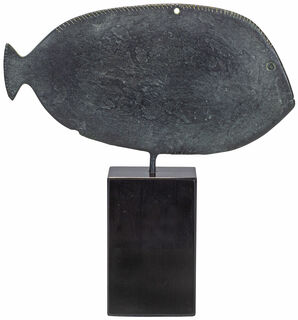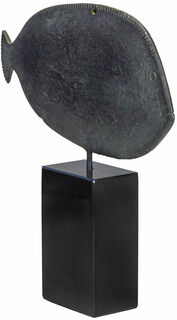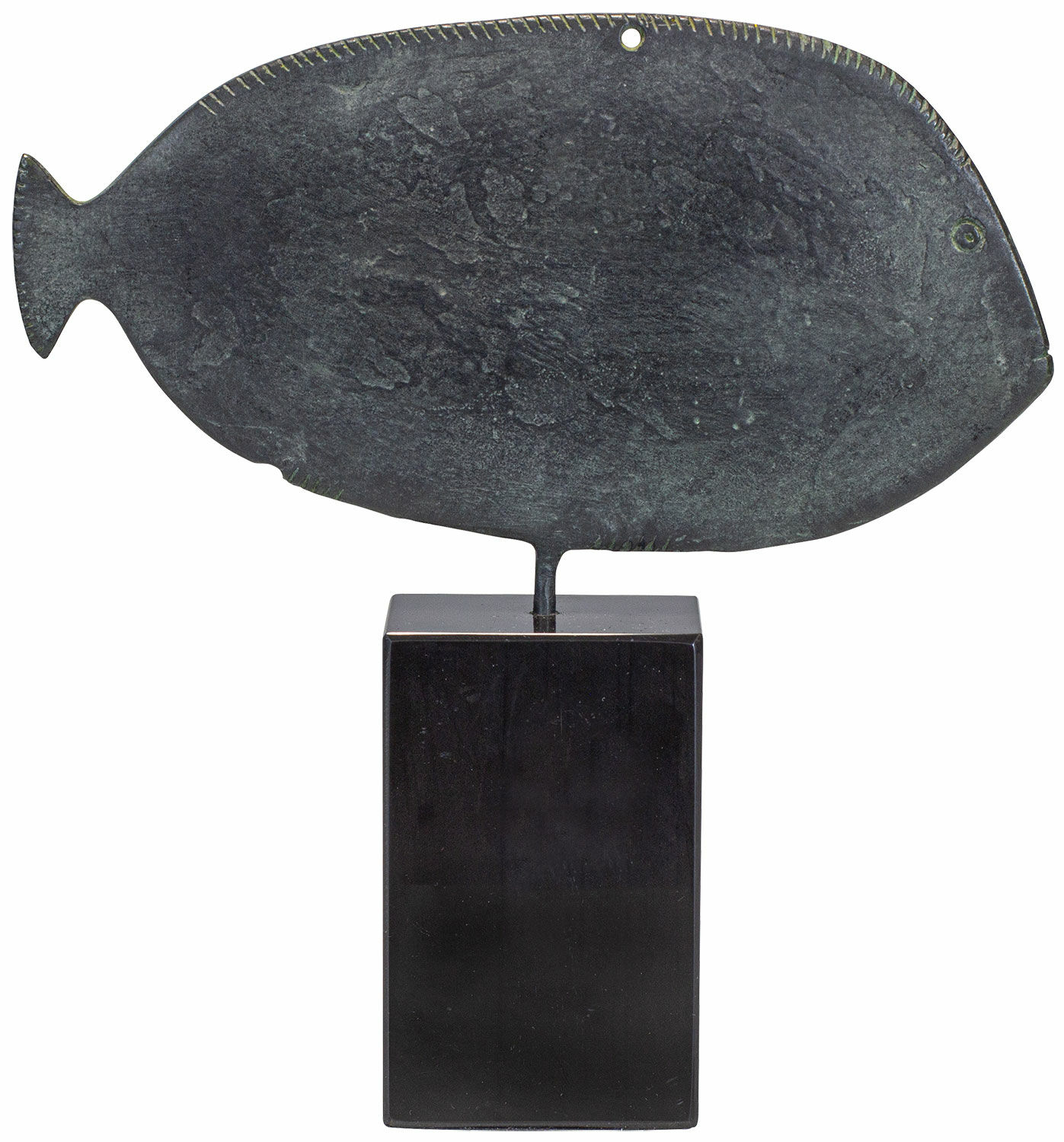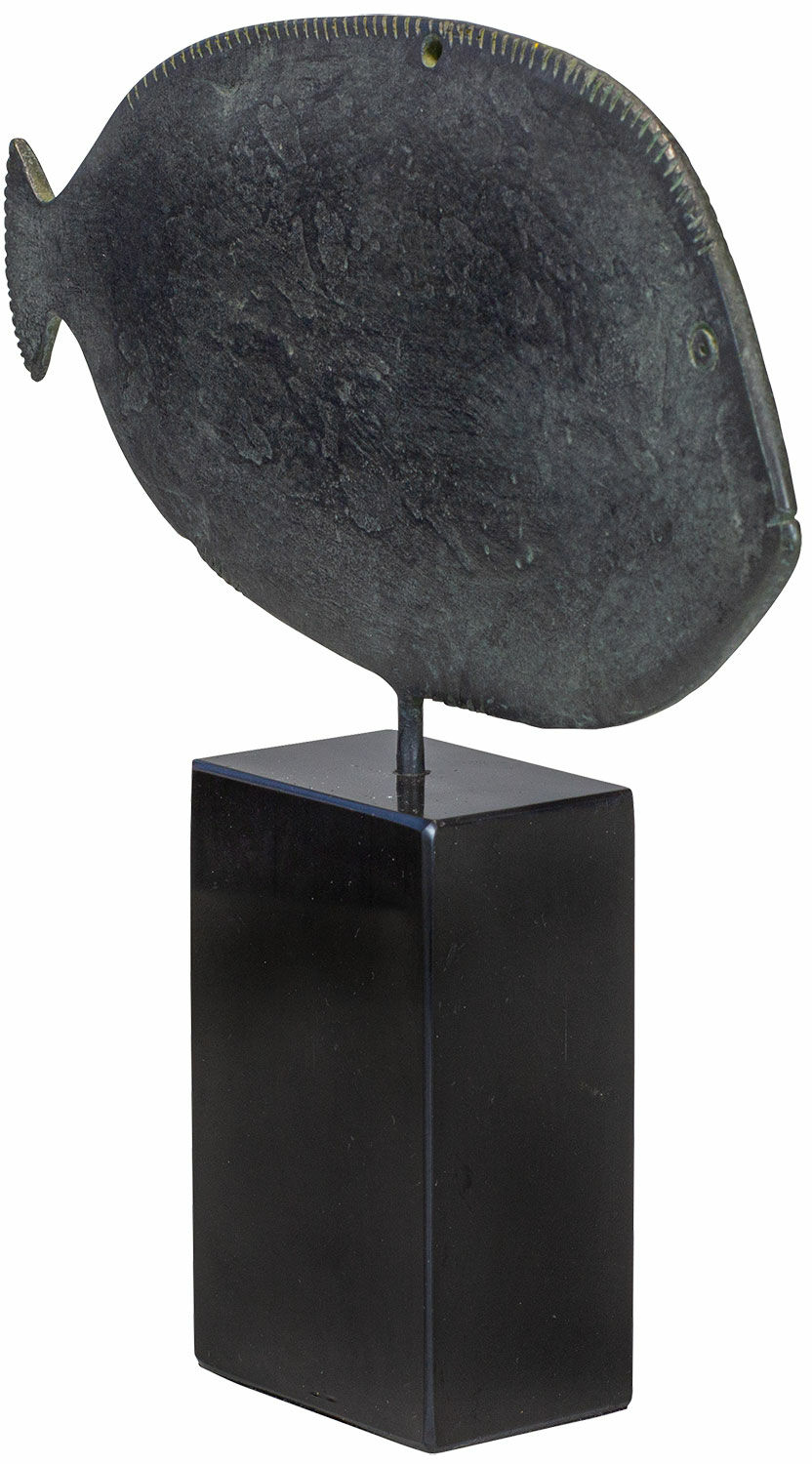Quick info
museum replica | bronze + marble | patinated | certificate | size total 19.5 x 3.7 x 18 cm (h/w/d) | weight approx. 1.1 kg
Detailed description
Sculpture "Egyptian Palette in the Shape of a Fish", bronze
To grind and apply their ingredients for facial or body cosmetics, the Ancient Egyptians used round or rectangular cosmetic pallets made of slate. The shapes evolved and became more sophisticated around the protohistoric period, culminating in shield-shaped pallets. In the 4th millennium BC, they seem to have acquired a different function and were transformed into ornamental and commemorative objects.
Original: Slate, Egypt, c. 3500 BC, Musée du Louvre, Paris.
Replica in bronze with fine patination, on a marble pedestal. With certificate of authenticity. Size including pedestal 19.5 x 3.7 x 18 cm (h/w/d). Weight approx. 1.1 kg.
An alloy of copper with other metals (especially with tin) used since ancient times.
When casting bronze, the artist usually applies the lost-wax technique which is dating back more than 5000 years. It's the best, but also the most complex method of producing sculptures.
First, the artist forms a model of his sculpture. It is embedded in a liquid silicone rubber mass. Once the material has solidified, the model is cut out. The liquid wax is poured into the negative mould. After cooling down, the wax cast is removed from the mould, provided with sprues and dipped into ceramic mass. The ceramic mass is hardened in a kiln, whereby the wax flows out (lost mould).
Now we finally have the negative form, into which the 1400° C hot molten bronze is poured. After the bronze had cooled down, the ceramic shell is broken off and the sculpture is revealed.
Now the sprues are removed, the surfaces are polished, patinated and numbered by the artist himself or, to his specifications, by a specialist. Thus, each casting becomes an original work.
For lower-quality bronze castings, the sand casting method is often used which, however, does not achieve the results of a more complex lost-wax technique in terms of surface characteristics and quality.
A true-to-the-original reproduction of an artwork in the same size and with the best possible material and colour uniformity.
The mould is usually taken directly from the original so that the replication reproduces even the finest details. After casting the replication, using the most appropriate method, the surface is polished, patinated, gilded or painted according to the original.
A replication of ars mundi is a recognizable copy of the original.
A plastic work of sculptural art made of wood, stone, ivory, bronze or other metals.
While sculptures from wood, ivory or stone are made directly from the block of material, in bronze casting a working model is prepared at first. Usually, it is made of clay or other easily mouldable materials.
The prime time of sculpture after the Greek and Roman antiquity was the Renaissance. Impressionism gave a new impulse to the sculptural arts. Contemporary artists such as Jorg Immendorf, Andora, and Markus Lupertz also enriched sculptures with outstanding works.
Early Dynastic Period and Old Kingdom (3000 - 2160 B.C.)
Already in the early period, around 3000 B.C., Egyptian art found its own style. Rules for representation were established that lasted for 3000 years. Writing and image representations were one single unit. The beginning of the Old Kingdom, around 2600 B.C., is marked by the emergence of the Step Pyramid of Djoser in Saqqara, the first king's tomb in the shape of a pyramid, a 545 x 280 meter sculpture, built entirely of stone. At that time, relief and painting served almost exclusively to the survival of people in the afterlife.
Intermediate Period and Middle Kingdom (2155 - 1650 B.C.)
New art that resulted from the Old Kingdom art, which was rich in cultural highlights and emerged after the reunification of the country under King Mentuhotep I in around 2040 B.C. The art of this period reached its peak with the royal portraits of the late 12th Dynasty Kings Sesostris II and Amenemhet III. During the 13th Dynasty and the subsequent domination by Asian invaders (Hyksos Period), monumental art declined. Small sculptures such as hippos and glazed animal figures made of fired clay embodied the hope for regeneration in the afterlife. The preferred burial object was the scarab, often decorated with the name of the deceased. The scarab was supposed to ensure life after death.
New Kingdom (1550 - 1070 B.C.)
The expulsion of “Hyksos“ was followed by a renewal of the spiritual life and the visual arts. The Temple of Amun in Karnak and the impressive Avenue of the Sphinxes were built. With the terraced temple of Hatshepsut, the construction of a series of royal funerary temples on the west bank of the Nile near Thebes began. At the beginning of the Amarna Period and the reign of Akhenaten (Amenhotep IV), the colossal statues returned to more „human“ measures. The king was no longer depicted in his exalted divinity, but in the circle of his family with the symbol of sun rays. The discovery of the tomb of Tutankhamun and the treasures it contained, gave us a deep insight into the art, culture and everyday life of an Egyptian pharaoh of the 18th Dynasty.
Under the successor kings Seti I and Ramses II, Egypt experienced building operations with the Great Hypostyle Hall of Karnak, The Abu Simbel rock temple and others, which did not allow any further increase. In the field of sculpture, stones were replaced by metals. The large bronze sculptures of the 22nd Dynasty finally led to the abundance of bronzes of gods and animals of the Late Period.
Late Period (712 - 332 B.C.)
In the Late Period of ancient Egyptian history, the tendency to imitate older works of art increased so that even today it is difficult to distinguish between an original of e.g. of the Middle Kingdom and a later „repetition“ of the work. The way back to the origins was sought in the multispace tombs that emerged during the 26th Dynasty in Thebes. Here, all major religious scriptures of the past have been passed down to posterity.
Graeco-Roman Period (332 B.C. - 395 A.D.)
When in 332 B.C. Alexander the Great succeeded to expel the Persians from Egypt, he was celebrated as a liberator and was crowned as pharaoh in Memphis. After Alexander's death in 323 B.C., the empire disintegrated due to ongoing succession disputes, until finally Alexander's general Ptolemy secured his dominion over Egypt in 305 and founded a dynasty that remained in power for 300 years.
After the assassination of Ptolemy XIII in 48-47 B.C., his sister Cleopatra VII took became the sole ruler. The Roman general Julius Caesar, who had tried in vain to mediate between Cleopatra and her brother, finally got himself into trouble and was forced to burn the Egyptian fleet, which was anchored in Alexandria. Cleopatra gave birth to Caesar's son and tried to secure his claim to the throne. After Caesar's death, she aligned with Mark Antony, whose victories brought Egypt dominion over the Middle East for the last time. The conflict with Octavian, later emperor Augustus, ended in defeat for Mark Antony in 31 A.D. He went back to Cleopatra and they both committed suicide. Thus Egypt became a province of Rome.






